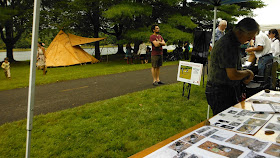Or the first of a series of sketches before the
12th Annual Native American-Archaeology Roundtable
“Our Hidden Landscapes: Native American Stone Ceremonial
Sites in the North American East"
to be held on:
Saturday,
October 28, 2017
at
The Institute for American Indian Studies (IAIS)
38 Curtis Road
Washington, Connecticut
06793
(860) 868-0518
You could say it’s a “massive stone wall,” large and heavy
or solid, as in "a massive rampart of stone," “impressively large” as
both Miriam and Webster put it when compared to the other rows of stones that
are found on and around the grounds of the Institute for American Indian Studies in
Washington CT, but that’s the word that comes to mind for me when looking at
the Stone Structure to the right of the driveway leading to the Research Building
where the 12th Annual Native American-Archaeology Roundtable will be held on Saturday,
October 28, 2017. The event is being called “Our Hidden Landscapes: Native
American Stone Ceremonial Sites in the North American East" but the “wall”
is hardly hidden, showing up on the Google Earth image below.
Drawing a line for
a path, I was just a little surprised to find the segment is about a quarter
mile long – 404 meters or 1,327 feet, about 442 yards long if I trust the dialogue
box that pops up when I use that feature.
I wrote a little bit about this “stone wall” a few years
back, noting that there were apparently capstones on top of this structure, http://wakinguponturtleisland.blogspot.com/2014/11/capstones-defined-sort-of.html,
but as the little sketch shows (I hope) there’s turtle imagery or iconography to
be seen in some of the more intact “capstones.”
What really changed my mind about this seeming “Estate Wall”
was a gateway that, at least to me, seems to recall other Great Serpent
Gateways, as I call them.
(Note the stone heaps above)
(Closer view with life-sized human dummy for scale)
(Enhanced and labelled LiDar View)
Take into consideration as well the adjoining rows that form
a rectangular area enclosed by similar massive “walls,” and you may begin to
think of this wall as a possible qusukqaniyutôk or ‘stone row, enclosure’ as Doug Harris and Paul A. Robinson
put it in “Ancient Ceremonial Landscape and King Philip’s War” (Northeast
Anthropology 2015:140). Please note that Harris and Robinson will be
speaking at this Roundtable event – and that I haven’t actually read what they
wrote but did see that Rolf Cachat-Schilling makes reference to the work in “A
Quantitative Assessment of Stone Relics in a Western Massachusetts Town” (2016
Massachusetts Archaeological Society) which you can find here:
Elaine Thomas (Mohegan) will also be speaking at the event and I have to remember to ask her about this photo and the similarities of these stone structures with those "Toot Stones."
(To be continued...)


































